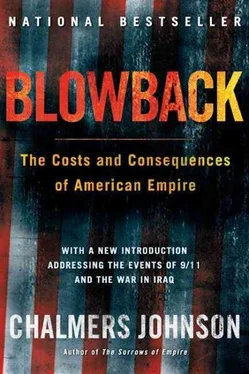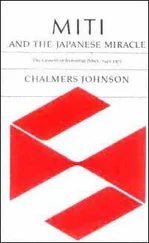Chalmers Johnson - Blowback, Second Edition - The Costs and Consequences of American Empire
Здесь есть возможность читать онлайн «Chalmers Johnson - Blowback, Second Edition - The Costs and Consequences of American Empire» весь текст электронной книги совершенно бесплатно (целиком полную версию без сокращений). В некоторых случаях можно слушать аудио, скачать через торрент в формате fb2 и присутствует краткое содержание. Год выпуска: 0101, ISBN: 0101, Издательство: Macmillan, Жанр: Старинная литература, на английском языке. Описание произведения, (предисловие) а так же отзывы посетителей доступны на портале библиотеки ЛибКат.
- Название:Blowback, Second Edition: The Costs and Consequences of American Empire
- Автор:
- Издательство:Macmillan
- Жанр:
- Год:0101
- ISBN:9780805075595
- Рейтинг книги:5 / 5. Голосов: 1
-
Избранное:Добавить в избранное
- Отзывы:
-
Ваша оценка:
- 100
- 1
- 2
- 3
- 4
- 5
Blowback, Second Edition: The Costs and Consequences of American Empire: краткое содержание, описание и аннотация
Предлагаем к чтению аннотацию, описание, краткое содержание или предисловие (зависит от того, что написал сам автор книги «Blowback, Second Edition: The Costs and Consequences of American Empire»). Если вы не нашли необходимую информацию о книге — напишите в комментариях, мы постараемся отыскать её.
Blowback, Second Edition: The Costs and Consequences of American Empire — читать онлайн бесплатно полную книгу (весь текст) целиком
Ниже представлен текст книги, разбитый по страницам. Система сохранения места последней прочитанной страницы, позволяет с удобством читать онлайн бесплатно книгу «Blowback, Second Edition: The Costs and Consequences of American Empire», без необходимости каждый раз заново искать на чём Вы остановились. Поставьте закладку, и сможете в любой момент перейти на страницу, на которой закончили чтение.
Интервал:
Закладка:
In an equally telling incident in 1990, the Matsushita Electric Company of Japan bought MCA Inc., the giant Hollywood-based entertainment conglomerate, for $7.5 billion, one of the biggest purchases ever of an American company by a foreign firm. This was less than a year after Sony had acquired Columbia Pictures for $3.4 billion and Newsweek had run a cover showing Columbia’s torch-bearing female icon wearing a kimono. 6In addition to by-then-widespread worries about Japanese capital invading the United States, there was the further complication that MCA owned a lucrative concession that serviced visitors to Yosemite National Park. In order to avoid the public relations embarrassment of having a Japanese company own part of a national park, the Department of the Interior suggested that Matsushita donate the concession to the park service. The Japanese, however, did not want to let it go and instead hired an elite corps of Washington lobbyists, lawyers, and public relations specialists to escort their purchase past congressional and government critics.
Leading the Matsushita team was former U.S. trade representative Robert Strauss. According to the Washington Post , he was paid $8 million for successfully brokering the deal and seeing to its public relations aspects, including getting the Department of the Interior to back off. When asked by reporters why he was being paid such an enormous fee for a minimal amount of work, Strauss nonchalantly replied, “I don’t work by the hour anymore. I don’t do windows.” 7This remark greatly puzzled the Japanese, although they were pleased enough with what their largesse had bought them. They concluded that Washington was as corrupt as Jakarta or Seoul and that anything could be had if the price was right. Rather than devoting attention to the potential pitfalls of their own brand of capitalism, the Japanese in this instance followed a distinctly American path and convinced themselves that they were invincible, while the United States was in a terminal decline. They therefore marched steadily toward their own decade-long economic downfall.
These alarms and diversions were also effective in turning American attention away from the most distinctive trait of Japan’s type of capitalism—namely, the major role given to governmental industrial policy and its role in a capitalist economy. Industrial policy refers to the attempt by the government to nurture particular strategic industries that are thought to be needed by an economy for reasons of national security, export competitiveness, or growth potential. 8As a result, most Americans failed to grasp how crucially Japan’s industrial policy depended on its political and military relationship with the United States and on access to its vast market. Nor did they understand that the Japanese were investing the huge trade profits in American Treasury securities that were, in turn, helping to finance America’s huge debts and making the American financial system critically dependent on Japanese savings. This growing dependency made American officials reluctant to criticize the Japanese in any way. Even when they did so, the Japanese rationalized such criticism as meant only for U.S. domestic consumption.
What Americans, including the revisionists, failed to see was that the Japanese economy, still devoted to exporting a vast array of ever more sophisticated and technologically advanced manufactured goods primarily to the American market, was generating an industrial overcapacity that would eventually threaten the health of the world economy. Moreover, as much of Asia began to emulate the Japanese form of capitalism or become offshore manufacturing platforms for Japanese corporations, this overcapacity threatened to reach crisis proportions. The crisis came to a head in 1997 and has been a continuing feature of the international economy ever since.
Political developments helped precipitate the crisis. In 1992, the Americans elected Bill Clinton on a slogan of “It’s the economy, stupid,” and in 1993, the Liberal Democratic Party in Japan, no longer needed as a bulwark against communism, simply collapsed of its own corruption and redundancy.
The Clinton administration did experiment briefly with policies advocated by the revisionists, including managed trade. The new administration even toyed with convincing the Japanese to join in helping manage Japanese-American trade, but its heart was never in it. The actual work was left to the usual array of Washington lawyers and economists, who had no East Asian knowledge or experience whatsoever, with the easily predictable outcome that the Japanese, much more experienced and better informed than their American adversaries, simply ran circles around them.
Using their huge leverage over American debt financing and Clinton’s need for the appearance of domestic economic prosperity in order to be reelected in 1996, the Japanese got the Americans to back down on most trade issues. The administration covered its tracks by claiming that it could not allow economic disputes to interfere with security and military matters. The difficulty was that except for the bellicose statements and deployments of the United States itself, peace was breaking out in East Asia. In 1992, for example, China recognized South Korea; that same year the government of the Philippines asked the U.S. Navy to leave the major base it had long occupied at Subic Bay. Still, the U.S. government claimed to see threats from North Korea and China, and the Japanese went along, doing whatever they could to satisfy the Pentagon.
In 1993, the Liberal Democratic Party lost its majority in the Japanese Diet for the first time in thirty-eight years. Increasingly irrelevant to Japan’s need to reinvigorate its economy and assume control over its foreign policy, it was not voted out of office but simply disintegrated. At first, a popular coalition government formed among the many new parties in the Diet. It seemed that a long overdue political realignment might be at hand. As it turned out, the Socialist Party, long feared by the United States because of its advocacy of “neutralism,” was so beguiled to be in office that it ultimately abandoned everything it had ever claimed to stand for and forged a cynical coalition with the LDP to control parliament. In the end, all the LDP’s loss of power revealed was that the party system itself had largely been postwar window dressing. In 1997, the LDP returned to power and resumed its stewardship over Japan’s old Cold War relationship with the United States.
At least, though, the rise to power in the 1993-97 interregnum of nonmainstream LDP and opposition party leaders opened up an important debate over how and why the country had become so rich and yet had such an ineffective elected government. Bureaucratic insiders as well as intellectuals and academics began publicly to acknowledge and elaborate on the very points the American revisionists had made. New York Times correspondent James Sterngold reported from Tokyo, “Five years ago, some Western critics were derided by the Japanese establishment as wrong—and probably racist—for declaring that Japanese policy was set by bureaucrats, not politicians, and that Japanese politics was often corrupt. . . . Suddenly, expressions and criticism previously regarded as blasphemous when uttered by ‘revisionists’ and ‘Japan bashers’ are spoken with a surprising matter-of-factness.” 9In the process they opened up whole new perspectives for viewing the interlocking Japanese governmental, social, and economic systems. They affirmed that a corps of unelected elite bureaucrats actually governed the country under a façade of democracy. They laid out the ways in which, working within a Cold War framework and guided by their government, the major corporations had invested in productive capacity many times greater than domestic demand could possibly absorb, thereby becoming totally dependent on continued sales to the American and Asian markets. They detailed the methods of the cartels, of restrictive licensing practices, of the underdeveloped system of judicial review, and of myriad other “nontariff barriers” to trade that kept American and European corporate penetration of the domestic market to a minimum.
Читать дальшеИнтервал:
Закладка:
Похожие книги на «Blowback, Second Edition: The Costs and Consequences of American Empire»
Представляем Вашему вниманию похожие книги на «Blowback, Second Edition: The Costs and Consequences of American Empire» списком для выбора. Мы отобрали схожую по названию и смыслу литературу в надежде предоставить читателям больше вариантов отыскать новые, интересные, ещё непрочитанные произведения.
Обсуждение, отзывы о книге «Blowback, Second Edition: The Costs and Consequences of American Empire» и просто собственные мнения читателей. Оставьте ваши комментарии, напишите, что Вы думаете о произведении, его смысле или главных героях. Укажите что конкретно понравилось, а что нет, и почему Вы так считаете.










